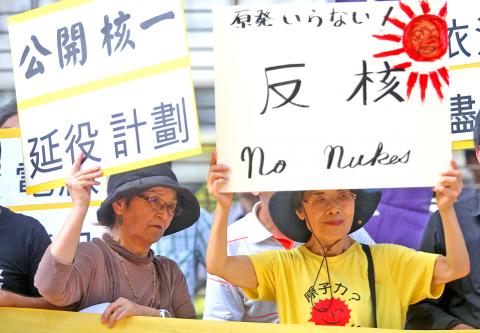Panelists at this year’s No Nukes Asia Forum (NNAF) in Taipei yesterday highlighted the risks posed by nuclear energy and its rapid expansion despite the Fukushima Dai-ichi nuclear power plant disaster three years ago.
NNAF Japan coordinator Daisuke Saito told the forum that three years after the meltdown in Japan, about 140,000 displaced residents still live in shelters.
Despite spending ¥10 trillion (US$91.7 billion) to remove a 10cm-thick layer of soil contaminated by nuclear radiation, the Japanese government has yet to succeed in purging the land, he added.

Photo: CNA
The hope to abolish nuclear energy is a universal one, Saito said, citing as an example Japan’s Kagoshima Prefecture, where discussions on the reactivation of Sendai Power Plant are taking place, prompting about 16,000 Tokyo residents to take to the streets last week to protest the plan.
An additional 8,000 Kagoshima residents rallied in their hometown — a remarkable display of public opinion in the rural prefecture, he said.
Saito also apologized in his capacity as a Japanese national on behalf of Japanese companies Hitachi Ltd and Toshiba Corp for exporting nuclear reactor modules to Taiwan that were used in the construction of the Fourth Nuclear Power Plant in New Taipei City’s Gongliao District (貢寮).
Mari Takenouchi, a Japanese reporter from Okinawa Prefecture, accused the UN Scientific Committee on the Effects of Atomic Radiation of publishing false studies that claim nuclear radiation is “harmless” to the human body.
Calling the committee’s move “criminal,” she said that the UN might appear to show concern over threats posed by nuclear power, but it is lobbying for development of the high-risk energy.
She said the chance of contracting thyroid cancer in Fukushima used to be one in 1 million, but after the nuclear accident, the figure rose to one in 3,000.
Takenouchi said the nuclear radiation emitted in the aftermath of the accident not only affected Fukushima residents, but spread across a vast area.
“My family and I were in Tokyo on March 15, 2011, when a nuclear cloud [generated from the Fukushima nuclear meltdown] passed over the city. During the several weeks that followed, my son developed fever 12 or 13 times, lost weight and had rashes all over,” she said.
Since the accident, many Fukushima residents reported symptoms including vomiting, abnormal nosebleed and loss of body hair, Takenouchi added.
Daniel Tam (譚棨禧), a member of the Hong Kong Alliance Against Nukes, warned of the rapid pace at which China is constructing nuclear plants in its coastal provinces, saying that it has least 20 operating plants and is planning to build 28 more.
“Countries all over the world have been more cautious with their nuclear energy policies after the Dai-ichi disaster. Yet, China is building nuclear plants at a speed unprecedented in human history,” he said.
“Hong Kong has been using nuclear energy for more than 20 years. Therefore, many Hong Kongers feel obligated to monitor the operation of power plants. I hope that the people of Taiwan and Hong Kong can have more interactions by disseminating information on this issue,” he said.

Beijing could eventually see a full amphibious invasion of Taiwan as the only "prudent" way to bring about unification, the US Department of Defense said in a newly released annual report to Congress. The Pentagon's "Annual Report to Congress: Military and Security Developments Involving the People's Republic of China 2025," was in many ways similar to last year’s report but reorganized the analysis of the options China has to take over Taiwan. Generally, according to the report, Chinese leaders view the People's Liberation Army's (PLA) capabilities for a Taiwan campaign as improving, but they remain uncertain about its readiness to successfully seize

Taiwan is getting a day off on Christmas for the first time in 25 years. The change comes after opposition parties passed a law earlier this year to add or restore five public holidays, including Constitution Day, which falls on today, Dec. 25. The day marks the 1947 adoption of the constitution of the Republic of China, as the government in Taipei is formally known. Back then the Chinese Nationalist Party (KMT) governed China from Nanjing. When the KMT, now an opposition party in Taiwan, passed the legislation on holidays, it said that they would help “commemorate the history of national development.” That

Taiwan has overtaken South Korea this year in per capita income for the first time in 23 years, IMF data showed. Per capita income is a nation’s GDP divided by the total population, used to compare average wealth levels across countries. Taiwan also beat Japan this year on per capita income, after surpassing it for the first time last year, US magazine Newsweek reported yesterday. Across Asia, Taiwan ranked fourth for per capita income at US$37,827 this year due to sustained economic growth, the report said. In the top three spots were Singapore, Macau and Hong Kong, it said. South

Snow fell on Yushan (Jade Mountain, 玉山) yesterday morning as a continental cold air mass sent temperatures below freezing on Taiwan’s tallest peak, the Central Weather Administration (CWA) said. Snowflakes were seen on Yushan’s north peak from 6:28am to 6:38am, but they did not fully cover the ground and no accumulation was recorded, the CWA said. As of 7:42am, the lowest temperature recorded across Taiwan was minus-5.5°C at Yushan’s Fengkou observatory and minus-4.7°C at the Yushan observatory, CWA data showed. On Hehuanshan (合歡山) in Nantou County, a low of 1.3°C was recorded at 6:39pm, when ice pellets fell at Songsyue Lodge (松雪樓), a